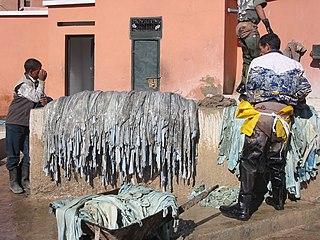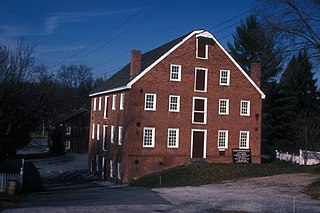
Tanning is the process of treating skins and hides of animals to produce leather. A tannery is the place where the skins are processed.

Acton is a community located in the town of Halton Hills, in Halton Region, Ontario, Canada. At the northern end of the Region, it is on the outer edge of the Greater Toronto Area and is one of two of the primary population centres of the Town; the other is Georgetown. From 1842 until 1986, the town was a major centre for the tanning and leather goods industry. In the early years, it was often referred to as "Leathertown".

Zadock Pratt Jr. was a tanner, banker, soldier, and member of the United States House of Representatives. Pratt served in the New York militia from 1819–1826, and was Colonel of the 116th regiment from 1822 until his resignation from the militia on September 4, 1826.

The Grahamsville Historic District is a historic district located along both sides of NY 55 just east of that hamlet in the Town of Neversink in Sullivan County, New York, United States. Its church is across the road from Tri-Valley Central School. In 1979 it was added to the National Register of Historic Places.
The United States Leather Company (1893-1952), was one of the largest corporations in the United States circa 1900, and one of the original companies in the Dow Jones Industrial Average. It was often referred to by contemporary sources as the "Leather combine" or "Leather trust".

Union Mills Homestead Historic District is a national historic district at Westminster, Carroll County, Maryland, United States.
Griffins Mills is a hamlet in the town of Aurora in Erie County, New York, United States. It lies on the West Branch of Cazenovia Creek in the area once known as West Aurora. Griffins Mills was founded in the early 19th century at the site of a mill. It is located in zip code 14170.

The Igualada Leather Museum, located in Igualada, Catalonia, was created in 1954 and was the first leather museum in Spain, and the third one in Europe. The collections are displayed in two nearby buildings in Igualada: the "Cal Boyer" building, a former cotton textile factory from the late 19th century, and the "Cal Granotes" building, an 18th-century tannery.

Joseph Reynolds was an American entrepreneur and founder of the Diamond Jo Line, a transportation company which operated steamboats on the upper Mississippi River. In his youth, while still living in upstate New York, he operated a butchery, a general store, a grain mill, and a tannery.

Bark mills, also known as Catskill's mills, are water, steam, horse, ox or wind-powered edge mills used to process the bark, roots, and branches of various tree species into a fine powder known as tanbark, used for tanning leather. This powdering allowed the tannin to be extracted more efficiently from its woody source material. A barker would strip the bark from trees so that it might be ground in such mills, and the dried bark was often stored in bark houses.

The Tannery is a historic tannery building constructed by the colonial Moravians in Bethlehem, Northampton County, Pennsylvania. It is a limestone building built in 1761, and is part of the Bethlehem Colonial Industrial Quarter.
Friedrich Vogel, more commonly known by the Americanized version of his name as Frederick Vogel, Sr., was an American tanner and businessman from Milwaukee, Wisconsin who spent a single one-year term as a member of the Wisconsin State Assembly. Together with his cousin Guido Pfister, he founded the Pfister & Vogel tannery.

The Prentice Co-operative Creamery Company in Prentice, Wisconsin was central to the community's transition from lumber to agriculture. It was added to the National Register of Historic Places in 1985.
Russia leather is a particular form of bark-tanned cow leather. It is distinguished from other types of leather by a processing step that takes place after tanning, where birch oil is worked into the rear face of the leather. This produces a leather that is hard-wearing, flexible and resistant to water. The oil impregnation also deters insect damage. This leather was a major export good from Russia in the 17th and 18th centuries because of its high quality, its usefulness for a range of purposes, and the difficulty of replicating its manufacture elsewhere. It was an important item of trade for the Muscovy Company. In German-speaking countries, this leather was also known by the name Juchten or Juften.
Pfister & Vogel (P&V) was an American tannery business in Milwaukee, Wisconsin.

August Hugo Vogel (1862–1930) was vice-president of Pfister & Vogel leather tannery of Milwaukee, Wisconsin.
Albert F. Gallun was president of A. F. Gallun & Sons in Milwaukee, Wisconsin. At the time, the company was one of the four largest leather-tanning operations in the United States.
A. F. Gallun & Sons was one of the largest tanneries in Milwaukee, Wisconsin and one of the four largest tanneries in the United States.

The Walker's Point Historic District is a mixed working-class neighborhood of homes, stores, churches and factories in Milwaukee, Wisconsin, with surviving buildings as old as 1849, including remnants of the Philip Best Brewery and the Pfister and Vogel Tannery. In 1978 it was added to the National Register of Historic Places. The NRHP nomination points out that Walker's Point was "the only part of Milwaukee's three original Settlements to reach the last quarter of the Twentieth Century with its Nineteenth and early-Twentieth Century fabric still largely intact," and ventures that "For something similar, one would have to travel to Cleveland or St. Louis if, indeed, so cohesive and broad a grouping of...structures still exists even in those cities."

Leather is created when an animal skin or hide is chemically treated in a process called tanning to preserve them for long term use as material for clothing, handbags, footwear, furniture, sports equipment and tools. Alligator leather is also commonly used to create similar items as mentioned above.













